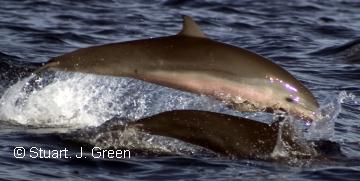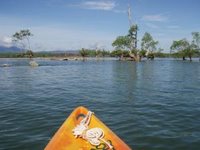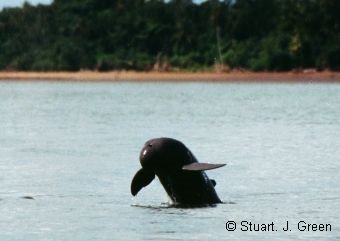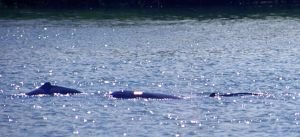
(This article first appeared in Vol. 59/3 2006 of the Malaysian Naturalist Magazine, published by the Malaysian Nature Society.)
I had been cruising the inshore waters for hours, scanning the sea for signs of marine life. It was a perfect day. The waters were calm, not the slightest swell on the mill pond-like surface of the South China Sea. The sun had burnt away the clouds leaving just the deep blue Borneo sky to watch over the boat and provide perfect visibility for the task at hand.
But despite the obvious perfection I had not seen what I came to see. That did not bother me. I was quite content to enjoy what is undoubtedly one of the most beautiful coastal areas in the whole of Sarawak, an area of beaches, mudflats and mangrove-lined rivers that is home to thriving fishing communities and some of Sarawak’s most interesting wildlife.
The waters offshore from Santubong were teeming with life, both human and animal, as they always are. In the hours before, with the forested slopes of Mount Santubong as a backdrop to the bay, I had watched a flotilla of fishing craft fan out across the river estuary and motor further out to sea. Tiny two-man fishing boats hugged the coastline, staying within the safe confines of the river, and small trawlers worked the seas further out. I had also observed Proboscis monkeys squabbling in the treetops of the mangrove forest, white-bellied sea eagles hovering overhead, and egrets feeding on the mudflats.
It had been a pleasant day, so pleasant I had almost forgot the reason that I was there, the same reason I am there on many occasions during the months from March to October, the same reason I spend hours in the hot sun, bobbing around in a small boat, my Ang Moh nose turning red in the sun, my appearance morphing into something that resembles the residents of the nearby mangroves, the proboscis monkey or orang belanda.
Wildlife watching consists of long bouts of boredom, and bursts of excitement that make the boredom worthwhile. After three hours on the boat I had not reached my limits of boredom - there was too much else going on for that to happen - but I was starting to get anxious and began to feel that it was not my lucky day.
And then it happened. One of those wildlife experiences that makes you want to grow long tufts of facial hair and study marine biology.

The first dorsal fin appeared twenty meters to the right of the boat, a brief five second burst of activity as the dark grey coloured Irrawaddy dolphin surfaced for air, two short characteristic rolls and it was gone, but there was just enough time to catch sight of its distinctive features – the blunt rounded head and stubby triangular dorsal fin. The Irrawaddy dolphin is unusual looking dolphin, quite distinct from other oceanic dolphins.
Off to the left, another blow for air, this time a mother and calf surfaced together, again a couple of short rolls, calf attached to the mother’s side, and they were gone. In front of the boat one individual poked his head vertically out of the water to have a look around, this spy hopping behaviour made easy by the Irrawaddy’s flexible neck.
Within a few minutes the whole group was surfacing around the boat, eight individuals in total. This was a relatively large group as Irrawaddys usually swim around in groups of 2-6 individuals, although larger groups of 15 dolphins have been reported.
The Irrawaddy is shy and elusive creature, and in no way does it live up to the clichéd image of a dolphin leaping in the air, bow-riding or other energetic displays. It is slow moving and normally only shows the rear half of its body, hiding most of its head in the water as it surfaces for air. In general, each surface consists of a short blow of air and one or two rolls before diving. Occasionally it shows its tail before a deep dive.
In short, the Irrawaddy is the pipe and slippers couch potato of the dolphin world. If cetaceans wore clothes the Irrawaddy would wear a tweed jacket with leather patches on the elbows. In most Internet dolphin watching polls the Irrawaddy doesn’t rank in the top twenty. This probably has as much to do with the fact that not many people have seen these creatures as to their relaxed behaviour.
Despite what others may think of this sedate, chilled-out creature, I can think of nothing better than spending a morning searching the waters of Santubong for Irrawaddy dolphins.
And that day was special.
The group near the boat was not the only group of Irrawaddy dolphins in the river mouth. Another group were circling a local fishing boat situated 50 metres or so away. I have seen this association with fishing boats on many occasions. Local fishermen in the Santubong area have a favourable attitude to the dolphins and are often seen throwing fish to them.
After hauling in their nets the fishermen sort out the ‘trash’, fish that can not be sold in the market. These fish are then thrown back in to the sea and the dolphins grab and easy free meal. The lone fisherman in his small wooden boat was doing exactly this and seemed to be enjoying the show as dolphins took it in turns, surfacing a couple of metres from the boat, grabbing their free lunch and waiting for more.
A third group of dolphins were feeding close to the mangroves next to the Damai Golf Course, just metres away from the unknowing golfers teeing off at the 16th hole. Three groups of Irrawaddy dolphins, perhaps a total of twenty individuals, all within sight of the boat, and all just 45 minutes from Kuching, the state capital of Sarawak.
It is not unusual to see large numbers of dolphins in and around Santubong. On occasions I have watched four or five groups, comprising up to thirty individuals, feeding in the relatively narrow confines of the Salak River.
Of the numerous trips I have made to observe Irrawaddy dolphins at Santubong this was the longest interaction I’ve had with a group of them. They had approached the boat and remained in and around the area for over an hour, surfacing regularly and indulging in periods of play and social interaction. I could not have asked for anything more. When one individual showed its fluke in preparation for a deep dive I knew it was time to slowly head back. The dolphins were moving on and so should I.
As I looked towards the sea in the direction the group was heading, I saw something I never imagined I would observe. The water near my boat opened up and the bulbous head of an Irrawaddy appeared, rapidly followed by a huge mass of flesh as the dolphin launched itself out the water, landing with an almighty crash, water spraying everywhere. A full ‘breach’ by one of the world’s most inactive dolphins, something I hadn’t seen in print, on TV or on the Internet, let alone in the wild.
The magnificent display was over in seconds but it is etched in my memory to this day. It was a close-up wildlife encounter, it was one of life’s perfect moments. But then Sarawak is that kind of place, a place that offers up more than its fair share of perfect moments.
----
The Malaysian Nature Society is the oldest environmental NGO in Malaysia. It is a membership-based organisation with branches across the country. For further details, check out http://www.mns.org.my/ . In Sarawak, the Kuching branch is quite active and regularly organises activities, events and field trips to learn more about Sarawak’s natural heritage. If you are in to nature and wish to join, email mnskuching@gmail.com














